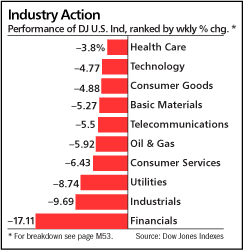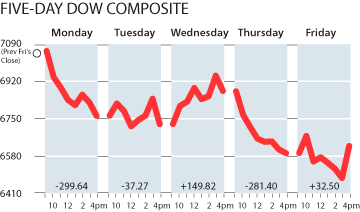The purpose of the Board's Business Cycle Indicators (BCI) is to provide ways for analyzing the expansions and contractions of the economic cycle. The Composite Index of Leading Indicators is one of three components of the BCI - the other two are the Composite Index of Coincident Indicators and the Composite Index of Lagging Indicators. Since the leading-indicators component attempts to judge the future state of the economy, it is by far the most widely followed.
Methodology of the Index of Leading Indicators The Index of Leading Indicators incorporates the data from 10 economic releases (which we review below) that traditionally have peaked or bottomed ahead of the business cycle. The exact formula for calculating changes in the leading index is rather involved but not necessary for understanding the indicator from our perspective here. (However, if you are interested, the formula can be found here on the Board's website). Each of the 10 components is averaged, and a standardization factor is applied to equalize volatility. (You can find the current standardization factors here.) In 1996 the value of the Index of Leading Indicators was re-based to represent the average value of 100, and the CB releases the data on a monthly basis. Below are the ten components that make up the composite indicator (charts of each component can be found here).
The 10 Components
Average weekly hours (manufacturing) - Adjustments to the working hours of existing employees are usually made in advance of new hires or layoffs, which is why the measure of average weekly hours is a leading indicator for changes in unemployment.
Average weekly jobless claims for unemployment insurance - The CB reverses the value of this component from positive to negative because a positive reading indicates a loss in jobs. The initial jobless-claims data is more sensitive to business conditions than other measures of unemployment, and as such leads the monthly unemployment data released by the Department of Labor.
Manufacturer's new orders for consumer goods/materials - This component is considered a leading indicator because increases in new orders for consumer goods and materials usually mean positive changes in actual production. The new orders decrease inventory and contribute to unfilled orders, a precursor to future revenue.
Vendor performance (slower deliveries diffusion index) - This component measures the time it takes to deliver orders to industrial companies. Vendor performance leads the business cycle because an increase in delivery time can indicate rising demand for manufacturing supplies. Vendor performance is measured by a monthly survey from the National Association of Purchasing Managers (NAPM). This diffusion index measures one-half of the respondents reporting no change and all respondents reporting slower deliveries.
Manufacturer's new orders for non-defense capital goods - As stated above, new orders lead the business cycle because increases in orders usually mean positive changes in actual production and perhaps rising demand. This measure is the producer's counterpart of new orders for consumer goods/materials component (#3).
Building permits for new private housing units - Building permits mean future construction, and construction moves ahead of other types of production, making this a leading indicator.
The Standard & Poor's 500 stock index - The S&P 500 is considered a leading indicator because changes in stock prices reflect investor's expectations for the future of the economy and interest rates. The S&P 500 is a good measure of stock price as it incorporates the 500 largest companies in the United States.
Money Supply (M2) - The money supply measures demand deposits, traveler's checks, savings deposits, currency, money market accounts and small-denomination time deposits. Here, M2 is adjusted for inflation by means of the deflator published by the federal government in the GDP report. Bank lending, a factor contributing to account deposits, usually declines when inflation increases faster than the money supply, which can make economic expansion more difficult. Thus, an increase in demand deposits will indicate expectations that inflation will rise, resulting in a decrease in bank lending and an increase in savings.
Interest rate spread (10-year Treasury vs. Federal Funds target) - The interest rate spread is often referred to as the yield curve and implies the expected direction of short-, medium- and long-term interest rates. Changes in the yield curve have been the most accurate predictors of downturns in the economic cycle. This is particularly true when the curve becomes inverted, that is, when the longer-term returns are expected to be less than the short rates.
Index of consumer expectations - This is the only component of the leading indicators that is based solely on expectations. This component leads the business cycle because consumer expectations can indicate future consumer spending or tightening. The data for this component comes from the University of Michigan's Survey Research Center, and is released once a month.
Thursday, June 19, 2008
Subscribe to:
Post Comments (Atom)


No comments:
Post a Comment